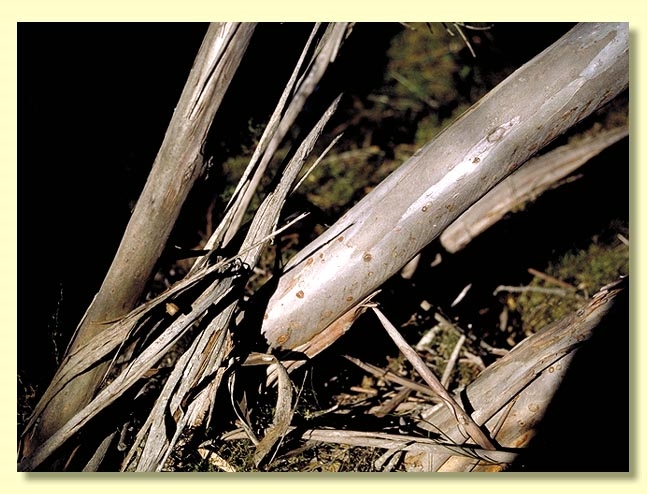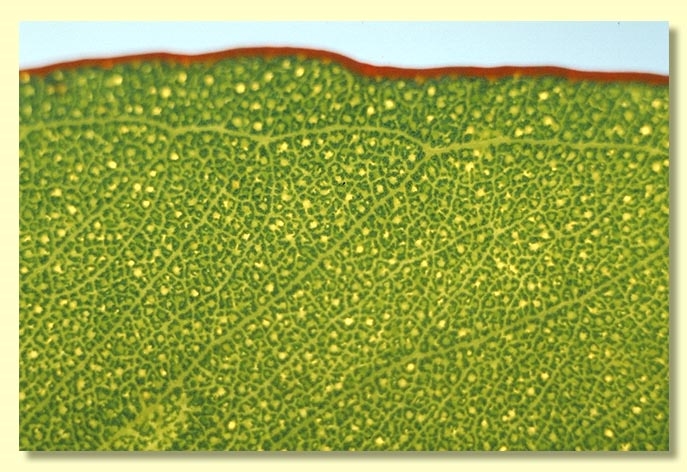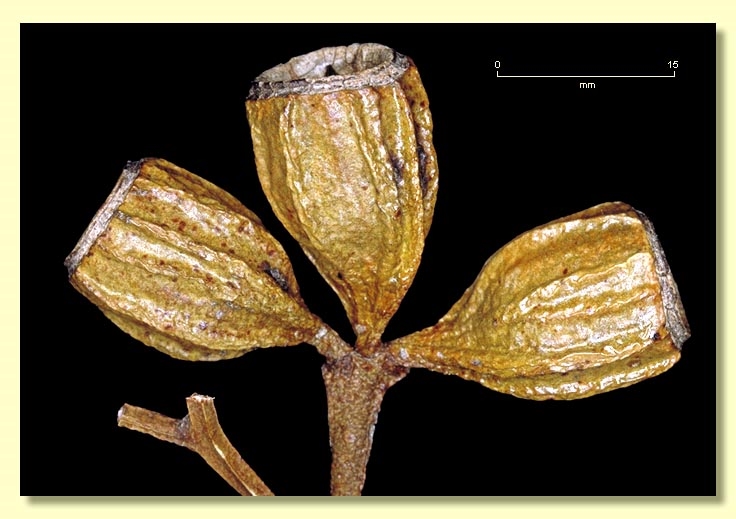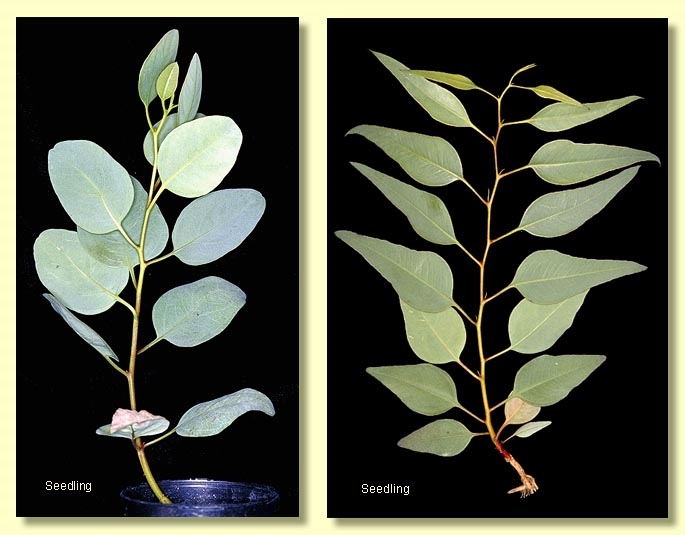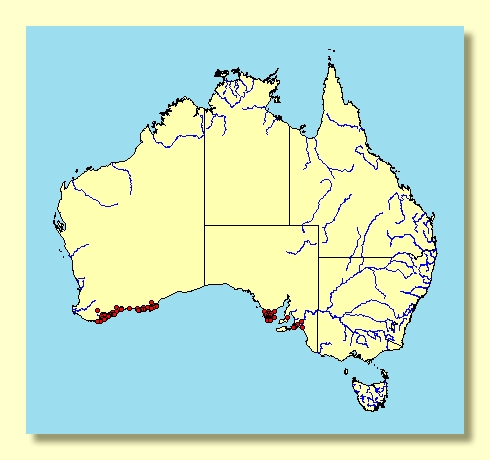Euclid - Online edition
Eucalyptus angulosa
Eucalyptus | Symphyomyrtus | Dumaria | Incrassatae
Eucalyptus cuspidata Turcz., Bull. Soc. Imp. Naturalistes Moscou 22(2): 21 (1849).
T: Western Australia: Swan River Colony, J.Drummond 4: 75; lectotype BM; isolecto: CGE, FI, K, PERTH, W. Refer to K.D. Hill et al., Telopea 9: 264 (2001) for further discussion.
Eucalyptus incrassata var. angulosa (Schauer) Benth., Fl. Austral. 3: 231 (1867) T: Australia, collector unknown; herbarium of cited specimen unknown to us.
Eucalyptus grossifolia L.A.S.Johnson & K.D.Hill, Telopea 9: 271 (2001). T: Western Australia: 1.3 km from Kambellup on Woogenellup rd (34° 34'S, 117°59'E), 12 Nov. 1986, K.D.Hill 2444, L.A.S.Johnson & D.F.Blaxell; holo: NSW; iso: PERTH.
Bark smooth throughout with some grey, loose imperfectly decorticated strips of rough bark accumulating on lower stems; smooth bark pale grey, grey-brown, white or pinkish to coppery with ribbons of decorticated bark in the upper branches.
Branchlets with or without pith oil glands.
Juvenile growth (coppice or field seedlings to 50 cm): stems rounded or square in cross-section; juvenile leaves alternate, petiolate, ovate or elliptical, 4.5–9 cm long, 2.5–4 cm wide, margin entire, green.
Adult leaves alternate, petiole 1–3 cm long; blade lanceolate to broadly lanceolate to ovate-elliptic, 5–14 cm long, 1.7–5 cm wide, base tapering evenly to petiole, margin entire or sometimes shallowly and distantly denticulate, thick, concolorous, glossy, green, side-veins greater than 45° to midrib, moderately to very densely reticulate, the veinlets erose, intramarginal vein well removed from margin, oil glands numerous, intersectional.
Inflorescence axillary unbranched, peduncles flattened, erect to spreading, 1–2.5 cm long, buds 3 or 7 per umbel, pedicellate, pedicels 0.1–0.7 cm long. Mature buds oblong to ovoid to pyriform, with coarse longitudinal ribs (1.5–2.7 cm long, 0.6–1.2 cm wide), scar present, operculum conical to shortly beaked (0.7–1.3 cm long), stamens inflexed, anthers cuboid to rounded, versatile, dorsifixed, dehiscing by longitudinal slits (non-confluent), style long, locules 3 or 4, the placentae each with 6 or 8 vertical ovule rows. Flowers creamy white to pale yellow (rarely pale pink).
Fruit pedicellate or occasionally sessile, (pedicels 0–0.5 cm long), cup-shaped, cylindrical, hemispherical or urceolate, 1.2–2.2 cm long, 1–2.5 cm wide, coarsely ribbed longitudinally, disc descending, valves 3 or 4, enclosed.
Seeds blackish grey, 2–4.5 mm long, flattened-pyramidal to D-shaped or cuboid, with ventral ridges, dorsal surface more or less smooth to slightly pitted, sometimes slightly lacunose, often with a narrow marginal flange, hilum ventral.
Cultivated seedlings (measured at ca node 10): cotyledons reniform; stems square or rounded in cross-section; leaves always petiolate, opposite for 2 to 6 nodes then alternate, deltoid to ovate, 4–8 cm long, 2–6 cm wide, base tapering, rounded or truncate, dull, grey-green becoming green.
Flowering has been recorded in April, August, September, October, November and December.
A mallee of the southern Australian coast from West Cape Howe to east of Esperance in Western Australia, and also southern Eyre Peninsula and southern Fleurieu Peninsula in South Australia but not on Kangaroo Island. The bark is smooth but the stems often have partly shed strips of bark hanging. The adult leaves are thick and broadly lanceolate.
Eucalyptus angulosa belongs in Eucalyptus subgenus Symphyomyrtus section Dumaria because the buds have two opercula, stamens are strongly inflexed, ovules are in 6 or 8 rows on the placentae and cotyledons are reniform. E. incrassata, E. angulosa, E. captiosa, E. singularis and E. ceratocorys are closely related within this section Dumaria, forming series Incrassatae.
E. angulosa is a mallee of coastal headlands and dunes with very coarse leaves, buds and fruits. E. incrassata, with slightly smaller buds, fruits and leaves, is sub-coastal to inland in distribution as a component of mallee communities. The narrow-leaved and small-budded subcoastal mallee, E. captiosa, and coarse-leaved inland mallee with buds that are contracted about the middle, E. ceratocorys, both have prominently beaked opercula. The fifth species in the series is the mallet E. singularis, which has pendulous buds on slender peduncles and pedicels and has prominently beaked opercula.
The recently described species, E. grossifolia, from the Kambellup area of Western Australia, south of the Stirling Range, is not recognised here as being sufficiently distinct from E. angulosa. It differs primarily in having a more open, erect habit which may be due to the subcoastal habitat, compared to the bushy habit of more coastal-growing plants of E. angulosa.
This Kamballup form of E. angulosa is locally important for land restoration work.


